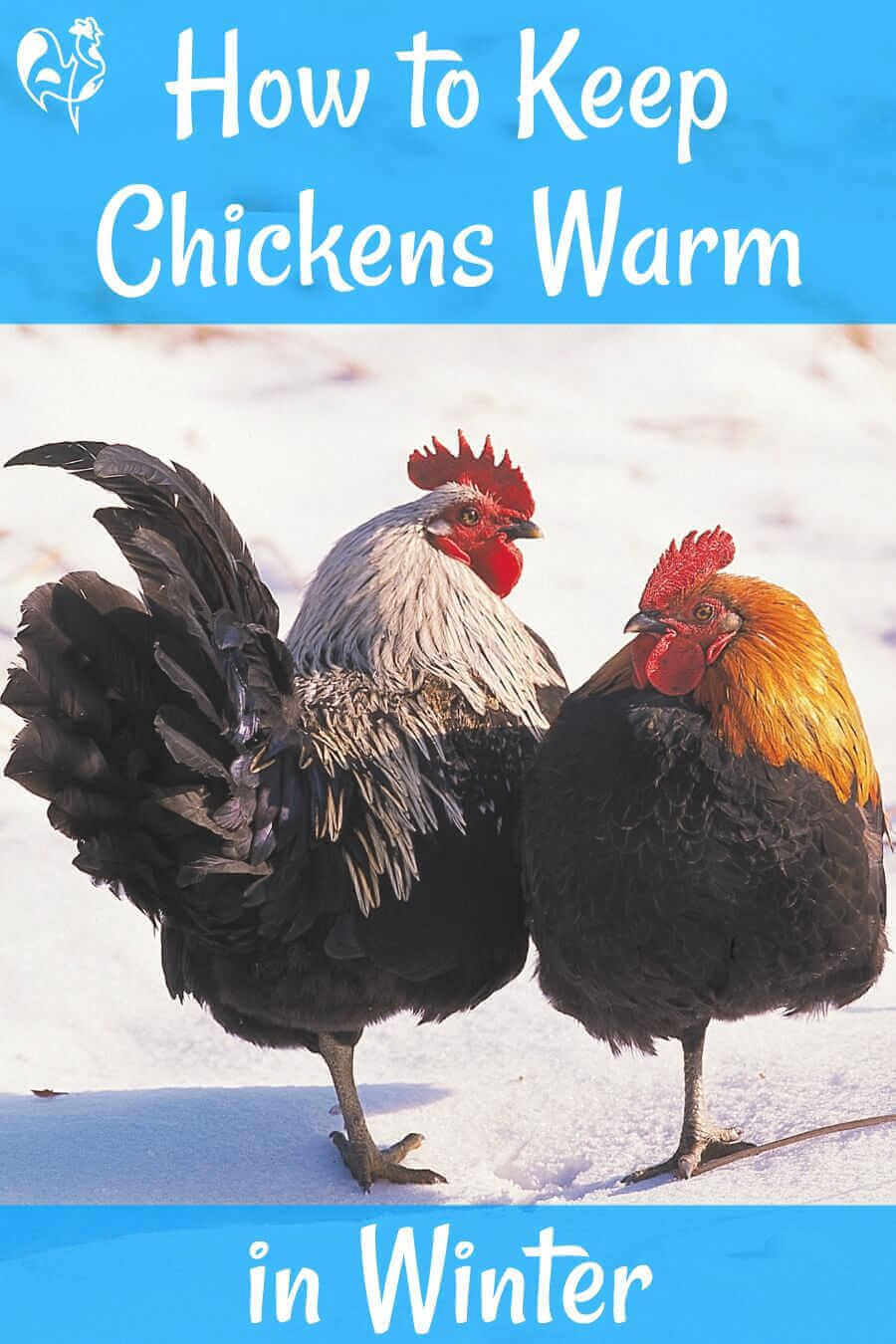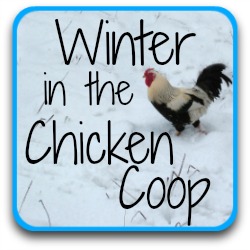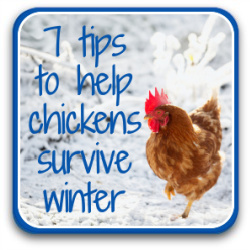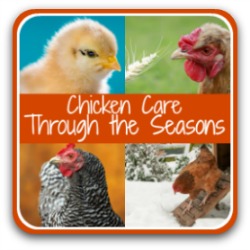- Home
- Winter care
- Keeping warm
12 simple, inexpensive steps to keeping chickens warm in winter.
The temperature has dropped way below freezing. What do backyard chickens need to keep them warm?
The answer is - nothing. Chickens are not people. They don't feel the cold like humans do. Think about it: bed coverings we use are often made from feathers. And chickens have plenty of those.
But what if you live in the really, really cold parts of the world? Isn't it necessary then to do something to help your flock?
Certainly. There are many things you can do to make sure your flock is protected against the cold - that's what this article is about.
But what people usually mean when they ask me "how can I keep my chickens warm" is "how should I heat my coop?"
And my answer to that is simple: do these things first. Heating the coop is rarely, if ever, necessary.
Protecting against the cold and, in particular, the damp, is more to do with taking steps to make sure your coop and run are adequate, and your chickens are healthy enough to withstand the pressures of winter.
In fact, it's true to say that chickens are much better able to deal with the cold than with heat. Many people, even in the depths of Alaska and northern Canada, where temperatures can reach as low as -15ºC (5ºF)(1), raise healthy chickens without resorting to additional heat in the coop.
Here are my 12 steps to healthy, happy, safe winter chickens. Click to the section you want - or keep reading.
1. Choose cold hardy breeds.
It may be too late if you have an established flock, but if you're just starting out or you're planning to add more chickens, take a look around your area at what knowledgeable chicken keepers choose. Some breeds are better at dealing with cold climates than others.
For example, chickens with large combs can suffer more than others with frostbite. Silkies, who have downy feathers, don't do well in cold, damp climates.
If you're not sure where to start, my recommendation would be the "ordinary" brown commercial chicken, often known as the Red Star. I have several in my flock and they withstand cold winters in Italy, where temperatures can fall as low as -15ºC (4ºF), exceptionally well.
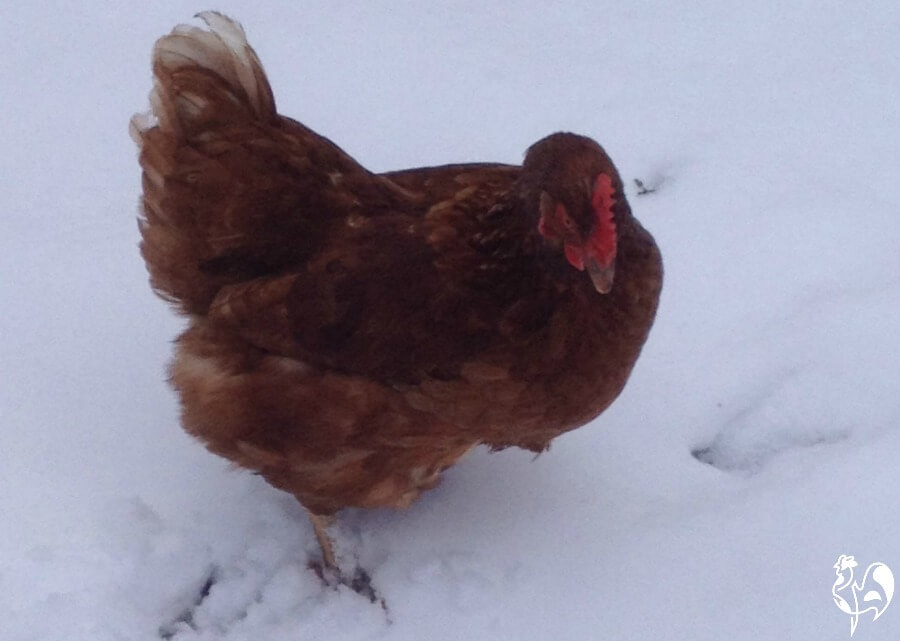 Claudia, one of my Red Stars, enjoying the snow in Italy.
Claudia, one of my Red Stars, enjoying the snow in Italy.2. Get more chickens!
The resting temperature of an adult hen is somewhere between 40ºC and 43ºC (105ºF to 109ºF). Her heart beats at around 400 beats per minute(2). This high metabolic rate in itself helps keep each chicken warm.
So when the flock is roosted together, they jointly add a considerable amount of heat to the coop without ever having to do anything else. In fact, there's evidence that each one adds the equivalent of a ten watt light bulb to the temperature(2).
This works particularly well in smaller, well insulated coops. Of course, if your chickens live in a large, draughty barn their body heat in itself won't be as effective.
3. Make sure roosts are wide enough to protect feet.
Feathers are what keep our chickens warm. Before winter sets in, chickens moult so that the good quality new feathers will provide excellent insulation during the hard winter months. Their feathers are such good insulators they're being trialled in the UK as a form of home insulation.(3)
Like wild birds, chickens keep their bodies warm by "fluffing up" to trap air between the different types of feather. What you may not know is that fluffing up also includes protection for their feet. In order to do that effectively, their roosts need to be a certain depth.
Make sure your roosts are the right size to keep your flock's feet warm this winter.
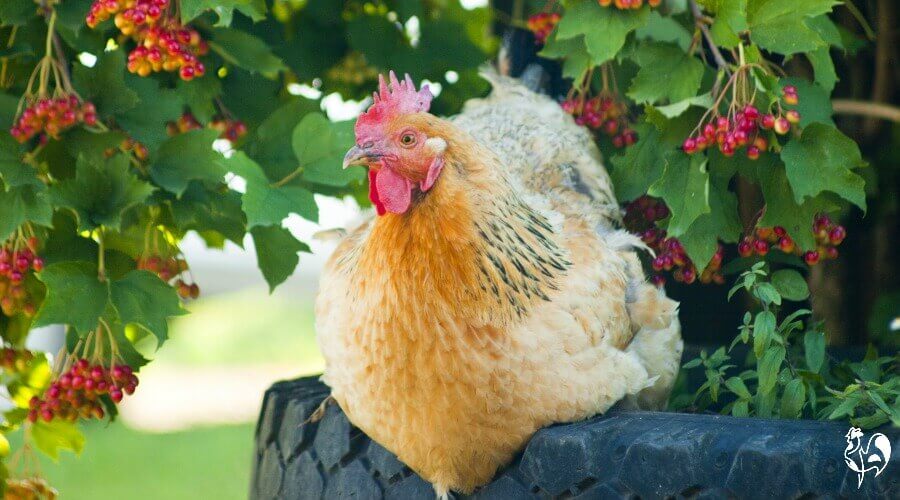 Hens prefer to cover their feet with feathers when they roost. Make sure your roosts are wide enough!
Hens prefer to cover their feet with feathers when they roost. Make sure your roosts are wide enough!4. Make use of the sun.
Most coops are placed in shaded positions in order to keep cool during the heat of summer. But in winter, the sun can be a friend.
Daylight hours may be short, but there will still be some sunlight during the day. If you have a chicken tractor, or a movable coop like an Eglu (which is also designed to keep warmth in), move it into the best position where the sun can warm it for as many hours as possible during the day.
Alternatively, move the coop into an enclosed space like a barn or large garage. There, you have double insulation.
And if you haven't yet bought a coop, consider buying one that you can move around according to the season.
5. Ventilate the coop to avoid moisture build-up.
The biggest danger to chickens in winter is not cold, but damp. Wet feathers cannot provide the insulation your flock needs at this time of year, and wet plus cold equals frostbite.
If your chickens spend more time inside in cold weather, their droppings inevitably build up and release ammonia - which even without damp can cause respiratory problems.
But if the damp from those droppings has nowhere to escape to, their warmth, plus warmth from the chickens themselves, will cause a build up of moisture. And that build-up will lead to mouldy bedding, spores and respiratory problems - in other words, a very sick flock.
To avoid that, make sure you have good ventilation above roosting height. It allows the moisture to rise and leave the coop, without chilling the birds.
6. Avoid draughts in the coop.
Ventilation is one thing. Draughts are another.
While your flock needs a well ventilated coop to allow moisture to escape, you need to make sure that cold air is not blowing directly onto them.
Stand in your coop and test whether you can feel cold air blowing in. Or worse - holes where rain and snow can come through.
Find the holes where the wind is blowing in, and block them. You don't need to go to expensive lengths for this. Old feedbags or some sacking will be perfectly adequate.
If you notice your chickens are wet before you have a chance to block up the holes, take them into the house and dry them out before you allow them out again.
And never allow chicks into the cold before they're properly feathered. They can't regulate their own heat.
Keep them in the brooder until they're big enough to withstand drops in temperature and can be moved outside with the big girls.
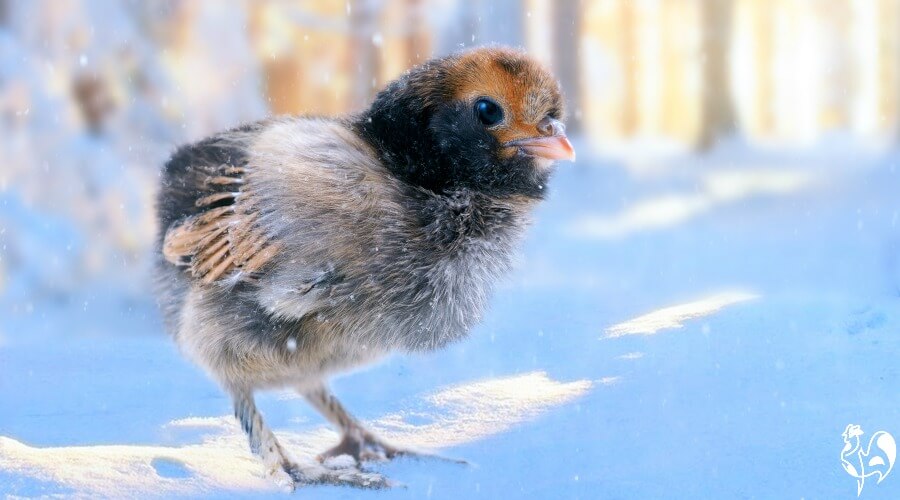 This chick is too young to be out in the snow. Wait until chickens are feathered.
This chick is too young to be out in the snow. Wait until chickens are feathered.7. Should you wrap your coop?
The short answer in most cases is "no". As we've seen, ventilation is critical in the winter. Making your coop completely airtight will create a moisture build-up and that can be fatal. It can also provide a cosy sleeping place for pests like red mite to hide.
There are, though, some small changes you can make to keep out the cold.
- Put strips of heavy plastic or fabric across the pop door. This allows the chickens access while keeping out cold draughts.
- If your coop is large - a barn, for example - put a smaller container in there for the birds to use to huddle together. Something as simple as a cardboard box, or a dog crate, works well.
- If temperatures drop drastically during the night in your area, wrap the lower part of the coop, leaving ventilation at the top. Some people use building ventilation (like Tyvek) but that can be expensive. Flattened cardboard boxes work well, or old carpet. It doesn't look pretty but it works!
- I add hay bales to the inside of the coop in the winter. There's no problem about fire risk because I don't have electricity in the coop. There's no doubt it helps keep warmth in, but the flock inevitably like to roost on it which makes it very messy.
- To avoid that, I cover the top in an easily cleanable linoleum and wash it (outside the coop, obviously) each day to make sure there's no chance of a moisture build-up.
- If you use hay or straw, be aware of the potential for it to become damp. Look carefully for signs of mould and mildew and if you see it, get rid of the bales straight away.
8. Use the deep litter method in the coop.
Using the deep litter method in a larger coop is an excellent way of providing winter insulation. I use it in my large, stone-built coop every year and have never yet had a chicken die from the cold. The temperature is always warm, despite Italian winters being incredibly cold.
Use at least ten centimetres (4") depth of wood shavings, straw or mixed bedding. I use a mix of straw, dried leaves and pine needles.
It's not, as is often said, an easy or "lazy" method - it requires regular upkeep. But it is certainly an appropriate way of retaining heat in cold winter months.
I have a detailed article about using and upkeeping the deep litter method, here.
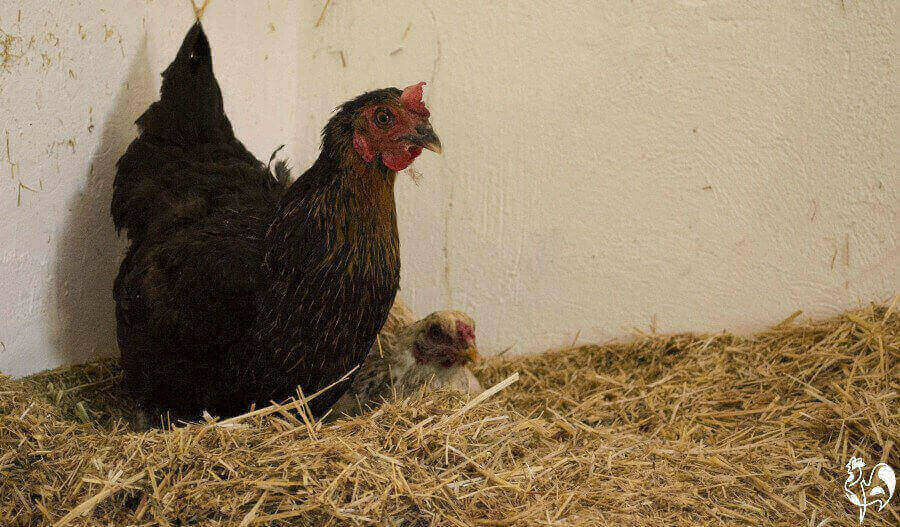 I use the deep litter method to help keep my stone built coop warm in winter.
I use the deep litter method to help keep my stone built coop warm in winter.9. Add wind protection to the run.
Bored chickens can easily start to display inappropriate behaviour, pecking and egg-eating amongst them. So you don't want to keep your flock "cooped up" all winter. They need to get out.
But what if the snow is deep and the wind chill, chilly?
- Make sure your chickens have some boredom-busters. "Kill the swinging lettuce" is always a favourite, and lettuce is one crop that grows well right through the winter.
- Try making at least part of your run wind-proof. Again, cardboard is your friend, as are tarpaulins or a heavy plastic. Tie them around the outside of the run to make a pleasant wind-shield area where the flock can gather.
- If you can, provide protection from above too, by hanging tarpaulins across the top of your fencing.
- Chickens will walk on snow but prefer not to. Dig them a path through, adding extra straw if there's a lot of water on the ground.
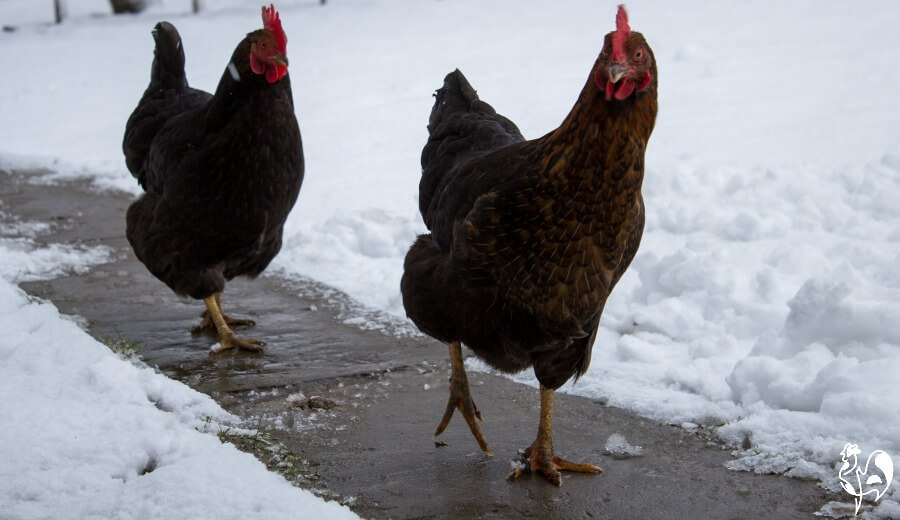 Your hens will thank you for digging them a path through snow!
Your hens will thank you for digging them a path through snow!Find 25 simple boredom busters for those extreme winter days!
10. Make sure water doesn't freeze.
Drinkers freeze easily in ultra-cold weather, but chickens need a constant supply of water to remain hydrated. So it's crucial that you make sure, one way or another, that water remains freely available.
Don't, though, keep water in the coop. You need as little moisture as possible inside, and the flock won't need water during the night. As long as it's available for them as soon as they leave the coop in the morning, they'll be fine.
- If you have no electricity in your coop and run, you'll simply need to make sure you replace near-frozen waterers with fresh water at least twice a day.
- Here's how to help waterers stay unfrozen for longer without electricity.
- Some people add a few drops of food grade glycerin to small drinkers to stop the water from freezing.
- If you have electricity in your coop or run, treat yourself to a heated drinker. Easy to use, it will make sure your chickens are never without water even in the coldest of climates.
(This link is an "affiliate" link, which means that if you click and buy something, I earn a small commission at no extra cost to you. Please note: I've never used one of these drinkers since they're not yet available in the EU. However, they have excellent reviews on Amazon).
- Finally, add a few drops of apple cider vinegar to water during winter months. Use it sparingly, not all the time. One tablespoon per gallon, added for one week in the month is enough. Some studies(4) have shown it helps boost the immune system which can ward off winter illness.
- However, there are also a lot of false and misleading claims made for apple cider vinegar. See this article for more detailed information about what it does and does not do.
11. Be food aware: use it to add to body heat.
Chickens eat more during the winter, as they use more energy to keep warm. Foraging becomes more difficult as the ground freezes and there are fewer berries and bugs in the cold. And feed becomes instantly wet as it hits the snow-covered, damp ground.
Take steps to avoid these issues:
- Keep feed in a pest-proof container and feed it in a weatherproof automatic feeder to keep it dry.
- Make sure to clear away any unwanted or spilled food at roosting time. Leaving it on the floor will attract rodents, who are looking for a good food supply at this time of year.
- Make sure your flock has free access to grit, as they won't be able to pick up as much naturally from frozen ground.
Add to their usual feed - but not too much.
- Beware of over-feeding chickens at this time of year. Yes, they'll eat more and you can add in some treats, but they'll be moving less in the snow and wind, and the chances of becoming obese - and dying from it - are raised.
- Look at offering some additional high protein foods - but don't overdo it.
- Scattering some mealworms around the chicken run for the flock to forage gives them additional energy but still requires them to work for it. Do this shortly before roosting time. The chickens will metabolise the worms overnight which helps keep their temperature raised.
- Don't overlook sprouting seeds in the winter to make sure your flock gets extra food that's high in nutrients but low in fat. And take a look in your local supermarket for damaged (not mouldy!) fruit and veg they're throwing out or reducing in price.
- I always save some sunflower seeds from my summer crop as a welcome winter feed.
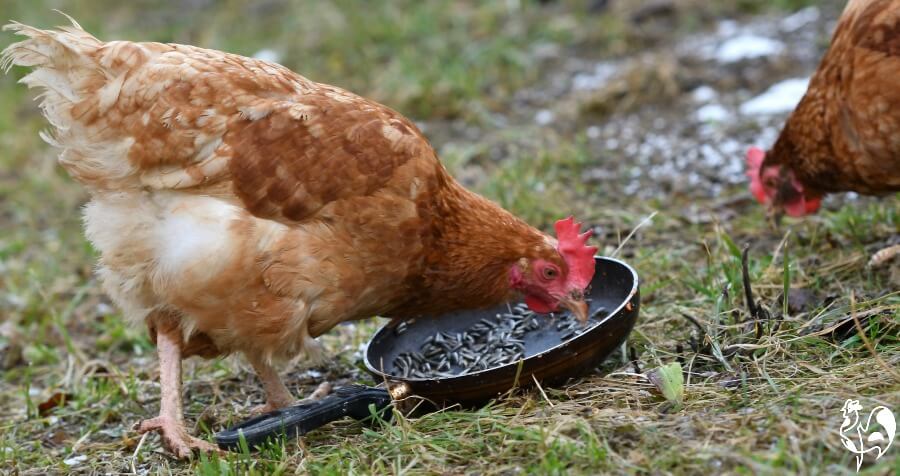
- Rose hips are another free food available in winter hedgerows, which are crammed with vitamins and will help boost your chickens' auto-immune system. See this article for details about how to feed them.
- Turmeric powder is a proven antibiotic in poultry care(5) and thought to increase the metabolic rate. It's therefore a good addition to winter feed.
12. If you're determined to heat your coop...
In my view, heating the coop is unnecessary, and can prove fatal. As long as your chickens have a weatherproof, well ventilated coop, a sheltered run, and adequate food and water, they will survive the winter without problems.
It's the summer months you need to be more concerned about.
Heating the coop can lead to some specific problems:
- If your flock is kept warmer than the outside temperature, a failure in the electrics or the device itself will cause the temperature to plummet. Chickens will not be able to cope with a sudden drop in temperature.
- The same applies when they leave the coop and suddenly find the external temperature much lower.
- Fires caused by heat lamps are commonly reported in the media as soon as temperatures drop. Faulty or poorly installed heat lamps, or chickens pecking through wiring, creates a spark which quickly spreads through wooden coops and straw bedding.
However, we all need to make decisions for our own circumstances. Sometimes, people tell me that no matter how persuasive arguments for not adding heat are, they cannot resist adding some form of heat lamp.
In that case, the only appliance I'd recommend is a wall mounted, flat panel radiant heater like this one...
But please - don't make the environment warm. Just lessen the chill in the air. And even then, be very, very careful.
Remember: chickens have thick, feathered coats. They are not people. They do not feel the cold to anything like the degree that we humans do.
Keep your chickens safe this winter.
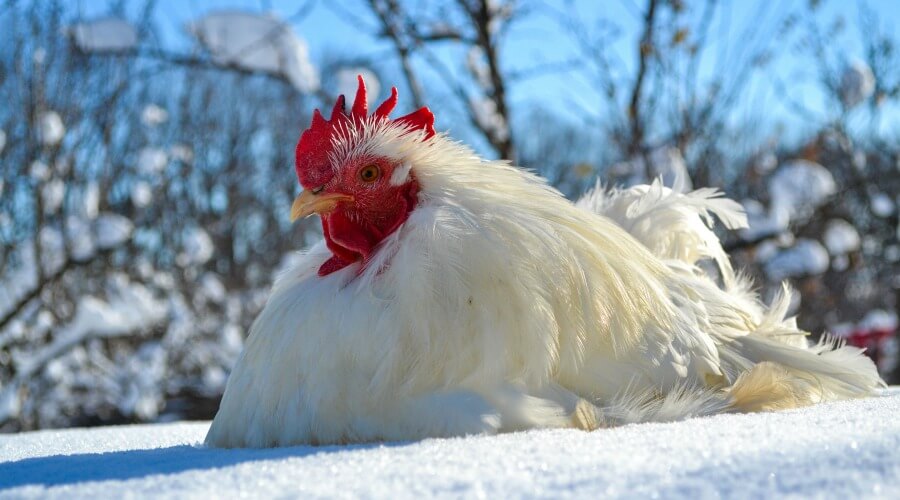
More articles about keeping backyard chickens healthy in the winter.
Sources and resources.
A lot of "facts" you'll find on the internet are often people's individual views, often based on inaccurate information repeated from poor quality sources.
The information I provide in this article and others is based not just on my own experience, but on evidenced facts from scientific, peer-reviewed research and evidence from highly respected and experienced poultry keepers such as Gail Dammerow.
Some of the sources I have used are these - click the link to read the full document:
1. Wikipedia: Climate of Anchorage.
2. University of Kentucky, College of Agriculture, Food and the Environment: Poultry Production Manual Chapter 7: Air Temperature. Pub. University of Kentucky, 2019.
3. Dowling, S: How chicken feathers could warm our homes. Pub. British Broadcasting Company, 2017.
4. Hayajneh, F., et al: Anticoccidial Effect of Apple Cider Vinegar on Broiler Chickens. Pub. Polish Journal of Veterinary Sciences, 2018.
5. Mahesh, M et al: Natural antibiotic effect of turmeric in poultry management. Pub. International Journal of Poultry Science, 2018.
- Home
- Winter care
- Keeping warm
